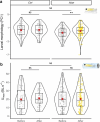Artificial light at night during early development directly affects embryonic but not larval quality in a wild coral reef fish
- PMID: 40584600
- PMCID: PMC12203906
- DOI: 10.1093/conphys/coaf041
Artificial light at night during early development directly affects embryonic but not larval quality in a wild coral reef fish
Abstract
Artificial light at night (ALAN) is an emergent yet already global form of sensory pollution. However, its effects on marine environments remain poorly understood compared to those on terrestrial ecosystems. Low-latitude ecosystems such as shallow coral reefs might be at greater risk as they experience little change in annual day length and reef organisms rely on moonlight illumination as a zeitgeber for critical biological processes. Moreover, many coral reef fish are demersal spawners, making them vulnerable to the effects of ALAN from early life. We performed a field experiment to determine whether artificial light affects the quality of fish embryos and newly hatched larvae by exposing wild nests of the orange-fin anemonefish (Amphiprion chrysopterus) to white light emitting diode (LED) light (22 ± 2.0 lx; 4000 K) throughout the 6-day embryonic development period. We also explored whether light pollution indirectly influences offspring traits by measuring parental care investment. Exposure to ALAN altered embryo quality, leading to a reduction in egg volume (2.40%) and yolk reserves (6.11%) alongside an increase in heart rate (7.42%) a few hours before hatching. These changes reflect higher metabolic demands of embryos developing under light-polluted conditions. As parental care investment was unaffected by light pollution, our results suggest that these effects are more likely the consequence of a direct effect of ALAN on embryogenesis. In contrast, there was no influence of artificial light on the larval morphology or swimming performance, suggesting that the direct effects of ALAN on fish embryos do not cascade onto the larval stage immediately after hatching. These results may suggest that embryos compensated for ALAN exposure to maintain their early post-hatching larval performance. Further studies are needed to investigate whether light pollution exposure during embryonic development has delayed effects on larval performance during the dispersal phase or on larval survival.
Keywords: ALAN; Pomacentridae; cascading effects; coral reef fish; early-life traits; ecological light pollution; offspring quality; parental care.
© The Author(s) 2025. Published by Oxford University Press and the Society for Experimental Biology.
Conflict of interest statement
The authors have no conflict of interest to declare.
Figures




Similar articles
-
A rapid and systematic review of the clinical effectiveness and cost-effectiveness of paclitaxel, docetaxel, gemcitabine and vinorelbine in non-small-cell lung cancer.Health Technol Assess. 2001;5(32):1-195. doi: 10.3310/hta5320. Health Technol Assess. 2001. PMID: 12065068
-
Home treatment for mental health problems: a systematic review.Health Technol Assess. 2001;5(15):1-139. doi: 10.3310/hta5150. Health Technol Assess. 2001. PMID: 11532236
-
Signs and symptoms to determine if a patient presenting in primary care or hospital outpatient settings has COVID-19.Cochrane Database Syst Rev. 2022 May 20;5(5):CD013665. doi: 10.1002/14651858.CD013665.pub3. Cochrane Database Syst Rev. 2022. PMID: 35593186 Free PMC article.
-
Interventions to reduce harm from continued tobacco use.Cochrane Database Syst Rev. 2016 Oct 13;10(10):CD005231. doi: 10.1002/14651858.CD005231.pub3. Cochrane Database Syst Rev. 2016. PMID: 27734465 Free PMC article.
-
Pramipexole in addition to mood stabilisers for treatment-resistant bipolar depression: the PAX-BD randomised double-blind placebo-controlled trial.Health Technol Assess. 2025 May;29(21):1-216. doi: 10.3310/HBFC1953. Health Technol Assess. 2025. PMID: 40455248 Free PMC article. Clinical Trial.
References
-
- Atherton JA, McCormick MI (2015) Active in the sac: damselfish embryos use innate recognition of odours to learn predation risk before hatching. Anim Behav 103: 1–6. 10.1016/j.anbehav.2015.01.033. - DOI
-
- Aubrecht C, Elvidge CD, Longcore T, Rich C, Safran J, Strong AE, Eakin CM, Baugh KE, Tuttle BT, Howard AT et al. (2008) A global inventory of coral reef stressors based on satellite observed nighttime lights. Geocarto Int 23: 467–479. 10.1080/10106040802185940. - DOI
-
- Barbasch TA, DeAngelis R, Rhodes J, Buston PM (2022) Parental care: patterns, proximate and ultimate causes, and consequences. In Laudet V, Ravasi T, eds, Evolution, Development and Ecology of Anemonefishes, First Edition. CRC Press, Boca Raton, pp. 159–166
-
- Barbasch TA, Rueger T, Srinivasan M, Wong MYL, Jones GP, Buston PM (2020) Substantial plasticity of reproduction and parental care in response to local resource availability in a wild clownfish population. Oikos 129: 1844–1855. 10.1111/oik.07674. - DOI
LinkOut - more resources
Full Text Sources
Research Materials

